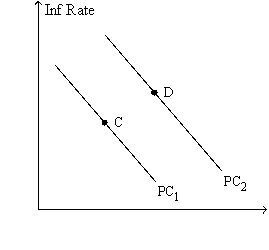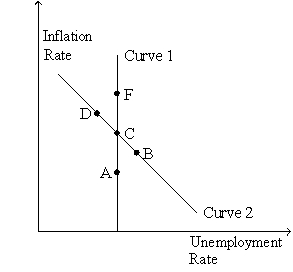A) rate of growth of the money supply.
B) minimum wage rate.
C) expected inflation rate.
D) All of the above are correct.
F) None of the above
Correct Answer

verified
Correct Answer
verified
Multiple Choice
Samuelson and Solow believed that the Phillips curve
A) implied that low unemployment was associated with low inflation.
B) indicated that the aggregate supply and aggregate demand model was incorrect.
C) offered policymakers a menu of possible economic outcomes from which to choose.
D) All of the above are correct.
F) B) and D)
Correct Answer

verified
Correct Answer
verified
Multiple Choice
Figure 17-8. The left-hand graph shows a short-run aggregate-supply (SRAS) curve and two aggregate-demand (AD) curves. On the right-hand diagram, "Inf Rate" means "Inflation Rate."

 -Refer to Figure 17-8. Subsequent to the shift of the Phillips curve from PC1 to PC2, the curve will soon shift back to PC1 if people perceive the
-Refer to Figure 17-8. Subsequent to the shift of the Phillips curve from PC1 to PC2, the curve will soon shift back to PC1 if people perceive the
A) increase in the inflation rate as a temporary aberration.
B) economic boom as a temporary aberration.
C) increase in the inflation rate as a sign of a new era of higher inflation.
D) economic boom as a sign of a new era of higher economic growth.
F) B) and D)
Correct Answer

verified
Correct Answer
verified
Multiple Choice
If inflation expectations rise, the short-run Phillips curve shifts
A) right, so that at any inflation rate unemployment is higher in the short run than before.
B) left, so that at any inflation rate unemployment is higher in the short run than before.
C) right, so that at any inflation rate unemployment is lower in the short run than before.
D) left, so that at any inflation rate unemployment is lower in the short run than before.
F) None of the above
Correct Answer

verified
Correct Answer
verified
Multiple Choice
Figure 17-5
Use the graph below to answer the following questions.
 -Refer to Figure 17-5. Curve 2 is the
-Refer to Figure 17-5. Curve 2 is the
A) long-run Phillips curve.
B) short-run Phillips curve.
C) long-run aggregate demand curve.
D) short-run aggregate demand curve.
F) All of the above
Correct Answer

verified
Correct Answer
verified
Multiple Choice
The analysis of Friedman and Phelps can be summarized in the following equation where a is positive number:
A) Unemployment Rate = Natural Rate of Unemployment - a(Actual Inflation - Expected Inflation) .
B) Unemployment Rate = Natural Rate of Unemployment - a(Expected Inflation - Actual Inflation) .
C) Unemployment Rate = Expected Rate of Inflation - a(Actual Inflation - Expected Inflation) .
D) Unemployment Rate = Actual Rate of Inflation - a(Actual Unemployment - Expected Unemployment) .
F) A) and D)
Correct Answer

verified
Correct Answer
verified
Multiple Choice
The arguments of Friedman and Phelps would suggest that other things the same, a country that pursues a disinflationary policy that the public does not find completely credible
A) should not see an increase in the unemployment rate even in the short run.
B) will having rising unemployment for a while, but then return to the natural rate of unemployment.
C) will have a permanently higher unemployment rate.
D) None of the above is suggested by the arguments of Friedman and Phelps.
F) B) and C)
Correct Answer

verified
Correct Answer
verified
True/False
Just as the aggregate-supply curve slopes upward only in the short run, the trade-off between inflation and unemployment holds only in the short run.
B) False
Correct Answer

verified
Correct Answer
verified
Multiple Choice
In 2009 Congress and President Obama approved tax cuts and increased government spending. According to the short-run Phillips curve these policies should have
A) raised unemployment and inflation.
B) raised unemployment and reduced inflation.
C) reduced unemployment and raised inflation.
D) reduced unemployment and inflation.
F) A) and C)
Correct Answer

verified
Correct Answer
verified
True/False
A decrease in the growth rate of the money supply eventually causes the short-run Phillips curve to shift right.
B) False
Correct Answer

verified
Correct Answer
verified
True/False
A given short-run Phillips curve shows that an increase in the inflation rate will be accompanied by a lower unemployment rate in the short run.
B) False
Correct Answer

verified
Correct Answer
verified
Multiple Choice
In the late 1970s, proponents of rational expectations argued that
A) the Fed should not attempt to aggressively fight inflation.
B) the sacrifice ratio was smaller than previously thought.
C) the short run was relatively long.
D) None of the above is correct.
F) A) and B)
Correct Answer

verified
Correct Answer
verified
Multiple Choice
If the Fed increases the growth rate of the money supply, in the long run which of the following is unchanged?
A) the unemployment rate and inflation
B) the unemployment rate but not inflation
C) inflation but not the unemployment rate
D) neither inflation nor the unemployment rate
F) A) and B)
Correct Answer

verified
Correct Answer
verified
Multiple Choice
If the natural rate of unemployment falls,
A) both the short-run Phillips curve and the long-run Phillips curve shift.
B) only the short-run Phillips curve shifts.
C) only the long-run Phillips curve shifts.
D) neither the short-run nor the long-run Phillips curves shift.
F) A) and B)
Correct Answer

verified
Correct Answer
verified
Multiple Choice
If the central bank decreases the money supply, then in the short run prices
A) rise and unemployment falls.
B) fall and unemployment rises.
C) and unemployment rise.
D) and unemployment fall.
F) B) and C)
Correct Answer

verified
Correct Answer
verified
Multiple Choice
Friedman argued that the Fed could use monetary policy to peg
A) nominal exchange rates.
B) the level of real GDP.
C) the rate of unemployment.
D) None of the above is correct.
F) B) and D)
Correct Answer

verified
Correct Answer
verified
Multiple Choice
When aggregate demand shifts left along the short-run aggregate supply curve,
A) unemployment and prices rise.
B) unemployment rises and prices fall.
C) unemployment falls and prices rise.
D) unemployment and prices fall.
F) C) and D)
Correct Answer

verified
Correct Answer
verified
Multiple Choice
If the long-run Phillips curve shifts to the right, then for any given rate of money growth and inflation the economy has
A) higher unemployment and lower output.
B) higher unemployment and higher output.
C) lower unemployment and lower output.
D) lower unemployment and higher output.
F) A) and B)
Correct Answer

verified
Correct Answer
verified
Multiple Choice
In his famous article published in an economics journal in 1958, A.W. Phillips
A) used data for the United States to show a negative relationship between the rate of change of the U.S. consumer price index and the U.S. unemployment rate.
B) used data for the United States to show a negative relationship between the rate of change of wages in the U.S. and the U.S. unemployment rate.
C) used data for the United Kingdom to show a negative relationship between the rate of change of the U.K. consumer price index and the U.K. unemployment rate.
D) used data for the United Kingdom to show a negative relationship between the rate of change of wages in the U.K. and the U.K. unemployment rate.
F) All of the above
Correct Answer

verified
Correct Answer
verified
Multiple Choice
Figure 17-2
Use the pair of diagrams below to answer the following questions.
 -Refer to Figure 17-2. If the economy starts at C and 1, then in the short run, a decrease in aggregate demand moves the economy to
-Refer to Figure 17-2. If the economy starts at C and 1, then in the short run, a decrease in aggregate demand moves the economy to
A) A and 2.
B) D and 3.
C) E and 3.
D) None of the above is correct.
F) A) and C)
Correct Answer

verified
Correct Answer
verified
Showing 341 - 360 of 367
Related Exams